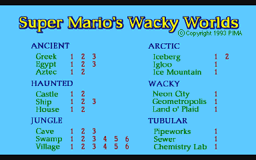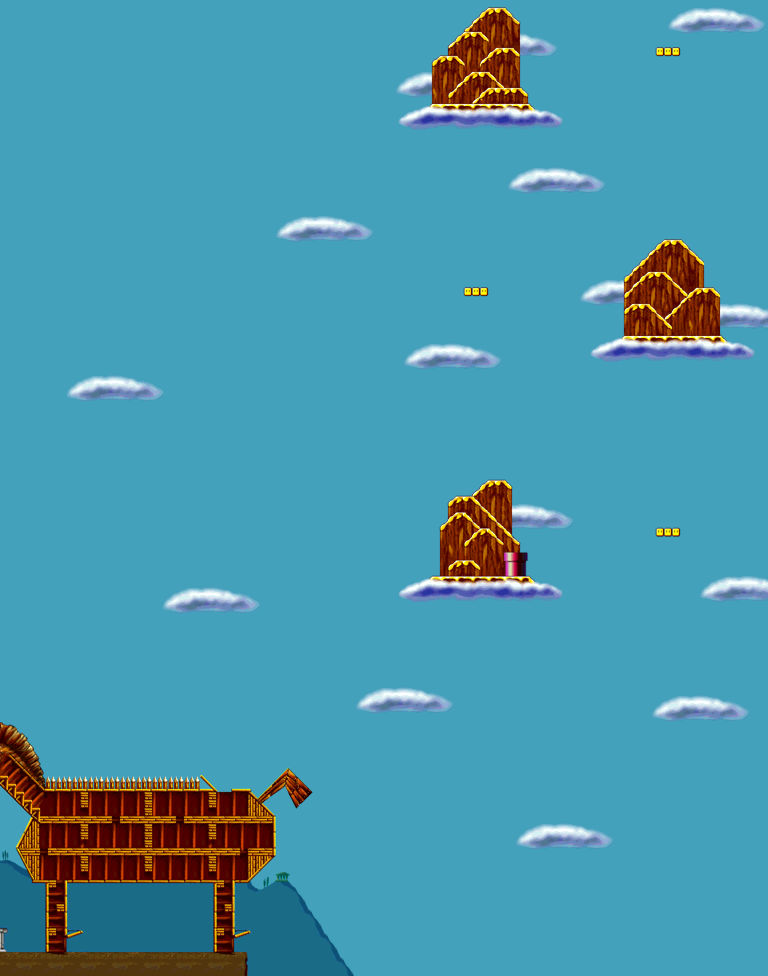Super Mario's Wacky Worlds

Welcome to the Super Mario's Wacky Worlds micropage! This should be your one-stop shop for info relating to this lost Nintendo CD-i title!
Sections:
Info Table -- Development -- Even Faster Facts
Links:
SMWW's Spriters' Resource Page -- -- SMWW's TCRF Page
Info Table
| Developer | Status | Available? | Genre(s) | Players |
|---|---|---|---|---|
| NovaLogic | Unreleased Cancelled mid-development due to corporate shenanigans |
Yes (v0.11 prototype) |
Action-Adventure Platformer |
1P |
Development
The entirety of this section is sourced from three interviews with the game's developers.
Development on Super Mario's Wacky Worlds ran from early 1992 - when the game's finalized outline proposal was approved - to June of 1993. It's unknown why NovaLogic was chosen to develop this title, though it's believed that they were chosen due to their previous CD-i experience, as well as some of its employees having worked on technically-demanding games. The game's outline was expanded into a full game specification document, with its main goals focusing on bringing high-quality graphics and sound into the Mario series, as well as some creative gameplay and a diverse selection of themes. The CD-i's visual and auditory capacities allowed NovaLogic to reach these goals.
Early in the game's development, a short demo was made by two NovaLogic developers, John Brooks and Silas Warner. The duo wanted to show the game off to Nintendo at an upcoming developer meeting, so they worked tirelessly for a couple of weeks to get a build up and running. This build featured a short section of an unknown level. It was shown off to Nintendo, who were impressed by the duo's work and applauded their efforts. Afterwards, it's claimed that Nintendo cancelled the project due to the CD-i's low sales. However, this clearly isn't the case as the game was worked on past this alleged shelving (and there's a second, more likely reason for its cancellation).
The design document of Super Mario's Wacky Worlds focused on having six distinct worlds with differing themes. Each world had three distinct lands with varying levels that increased in difficulty. There were plans to have around 60 to 70 levels in the final game - in the known prototype, there are 40. Puzzles were planned for these levels; the only known example involves sliding stone blocks in Egypt's pyramid, which Mario had to avoid or else he'd be crushed. A giant, Swiss Family Robinson-styled treehouse was planned for the Jungle world, likely the Village level mentioned in the prototype. Furthermore, there was a "puzzle mechanism" planned for the game which transported Mario between the levels AND the worlds.
The game's sprites were traced over the ones from Super Mario World and were taken from a video recording, while the levels were paper drawings that were digitized. The levels in particular were specifically designed to be within the capabilities of the CD-i but also fun, visually appealing, and challenging. This aspect of development went over rather smoothly apart from some engine and art-related hiccups.
Multiple bosses were designed for the game and were at a functional state before its cancellation. These included a giant rolling stone head in the Aztec level and some unknown bosses that were multi-segmented and moved like snakes. It's unknown if Bowser was meant to be involved in the game's plotline or not.
Several critical console-side problems were encountered during the development of Super Mario's Wacky Worlds, but due to the team's experience and scaled-back ambitions for the project, these problems were either minimized or outright eliminated. Even then, there were some things that had to be changed due to the CD-i's limitations, such as a planned implementation of Yoshi. Mechanics such as scrolling backgrounds and shells/mushrooms were still being worked on when the game was cancelled.
An ongoing problem the developers faced during the development of Super Mario's Wacky Worlds was recreating the feel of Super Mario World, as the dev team had great respect and admiration for the Mario series and wanted to have the game appeal to the series' fanbase. To do this, they tried to recreate the game's mechanics as closely as possible (even using a SMW guide as a reference), while keeping it fresh with new characters and locations. The team had partially managed to reach this goal by the time the project was cancelled. Nintendo did not have any (known) influence over the project's development at this point in development. Philips was slightly more active - they were involved with producing/monitoring the development of the game as well as being NovaLogic's technical support.
What ultimately killed Super Mario's Wacky Worlds was NovaLogic's greediness. The company wanted to spend as little money and resources on the game as possible, including staff members. The reason for this was that Philips spent a large amount of money on producing titles for the CD-i, and this included handing it over to third-party developers. NovaLogic was secretly keeping SMWW alive as a "shell game" that provided a steady flow of funds for projects like Comanche series of games. Apparently, several other CD-i developers did this exact thing.
However, the Super Mario's Wacky Worlds development team grew disillusioned by NovaLogic focusing on money-making instead of putting the time and resources into it. The crew slowly left the company one-by-one until June 1993, when NovaLogic's president shelved the project as only one employee was still working on the project. This was sudden - Philips weren't told in advance, and the decision surprised them.
At some point in the late 2000s, a disc containing the v0.11 prototype of Super Mario's Wacky Worlds (dated March 3rd, 1993) was sold on eBay for around $1,000. This is the prototype you can download and play on whatever file-sharing site you love using most.
Because there's actually a prototype available to play, there's not much point in writing about the gameplay of Super Mario's Wacky Worlds. You can read the MarioWiki article if you want to learn about that aspect.
I'll leave you with some fast facts about the game...
Even Faster Facts
Early Game Blurb
Packaged with early CD-i titles was a catalog that contained a list of released and upcoming titles for the system. This catalog was updated a few times, and appears to have stopped being used around 1993 or 1994. A specific late 1992 catalog (packaged with Laser Lords and likely several other titles) had early (and mistake-filled) plot descriptions for four of the CD-i Nintendo titles. This includes The Faces of Evil, The Wand of Gamelon, Hotel Mario, and Super Mario's Wacky Worlds - unfortunately, none of the other titles got a mention.
This is the blurb for the unreleased Super Mario's Wacky Worlds:
SUPER MARIO'S WACKY WORLDS To save Princess Toadstool, Mario
must travel through Ghost World, Ice World, Ruins World, Jungle World, Artificial World,
and Tubular World. His fate is in your hands.
Notably, it actually gives the game a plotline - Princess Toadstool would've been kidnapped (by Bowser?) and Mario would've gone through the wacky worlds to save her. It also has an alternate order for the worlds as well as new names; in the lone prototype, they're called Haunted, Arctic, Ancient, Jungle, Wacky, and Tubular respectively.
Could this be the proposed outline mentioned in the developer interviews? Who knows.
The Lost Levels
The following levels cannot be accessed in the prototype of Super Mario's Wacky Worlds, as their assets do not exist on the disc (and were likely never made before cancellation).
Their level select name is listed first, followed by their internal names.
- Aztec 1, Aztec 2
(AZTEC1, AZTEC2) - House 1, House 2
(HOUSE) - Swamp 6
(SWAMP6) - Village 1, Village 2, Village 3, Village 4, Village 5, Village 6
(VILLAGE, HUT1, HUT2, HUT3, HUT4, HUT5) - Sewer 1
(SEWER) - Chemistry Lab 1
(CHEMLAB)
Village's internal naming system, combined with the development fact about the Jungle world's treehouse level, implies that it would've had a similar structure to Swamp. It's also interesting that the House levels share the same internal name instead of using two separate ones.
Unseen Areas
Due to a lack of flight/swimming mechanics within Super Mario's Wacky Worlds, a few areas can never be explored by Mario. Fortunately, ogarvey on the Spriters' Resource has ripped all of the prototype's stages, allowing these unseen areas to be viewed in full. I'll post the two most notable revelations here.
NOTE: I had to shrink the maps down to fit on the page. You can view the originals using the Spriters Resource link at the top of the page.

Most of the second stage of Greek goes completely unused. Mario can only explore the area in and around the Trojan Horse on the bottom-left, and can never explore any of the clouds or floating islands in the sky. Presumably, Mario would have to enter the pipe on the southwestern island to proceed to the next level.

It's impossible to reach the ending of Ship 3 as Mario can't jump high enough to reach the area on the top-right. Not that much was lost, mind - it's just a S-bend followed by (presumably) the exit pipe.
Return to top
Last updated: August 12th, 2025.